Ornamental plants and flowers with red leaves: their names, brief descriptions and illustrations
Some plant species contain in the leaves, in addition to chlorophyll (which gives the leaves green color), and other color pigments. If the pigment content predominates, then the leaves are colored in its color. For example, a high content of anthocyanins leads to the formation of leaves with red tints (the same purple or violet). This color increases the decorative properties of flower beds and indoor plants.
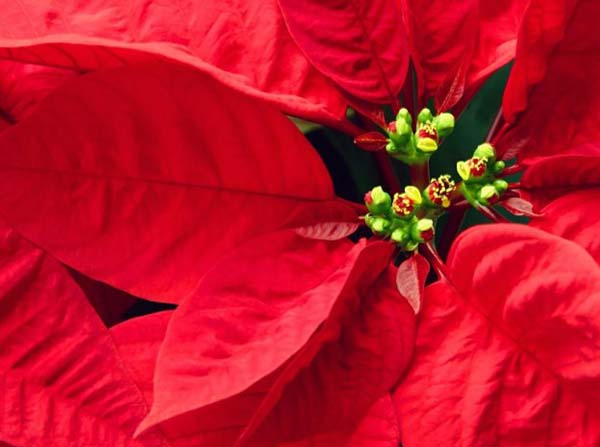
Content
- 1 Ornamental plants and flowers with red leaves
- 1.1 Alternantera
- 1.2 Amaranth
- 1.3 Badan
- 1.4 Ever-flowering begonia
- 1.5 Geichera
- 1.6 Maple-leaved hibiscus (red-leaved or sour)
- 1.7 Hypoestes or gepests
- 1.8 Creeping insect
- 1.9 Morning glory Sweet potato varieties "Blackie"
- 1.10 Irezina Herbst
- 1.11 Canna garden
- 1.12 Violet oxalis (triangular)
- 1.13 Creeping clover
- 1.14 Castor oil plant
- 1.15 Coleus
- 1.16 Croton (Codium) motley
- 1.17 Toadflax purple varieties "Canon J.Went"
- 1.18 Small-headed Highlander Red Dragon (Red Dragon)
- 1.19 Rogers feathery
Ornamental plants and flowers with red leaves
Below you will find brief descriptions, varieties and features of growing the brightest representatives of red-leaved plants and flowers.
Important! Plants and flowers with red leaves, as a rule, do not like too sunny areas, they are better suited for slightly shaded places (partial shade). As for their bloom, they look more luxurious in the sun, so you have to find some balance. But there are also exceptions.
Alternantera
Herbaceous perennial plant with many small lanceolate leaves. Their color is the main decorative feature. Flowers are small, white, inconspicuous. The stems are fragile, branching.
The most popular red variety is Purple Knight.
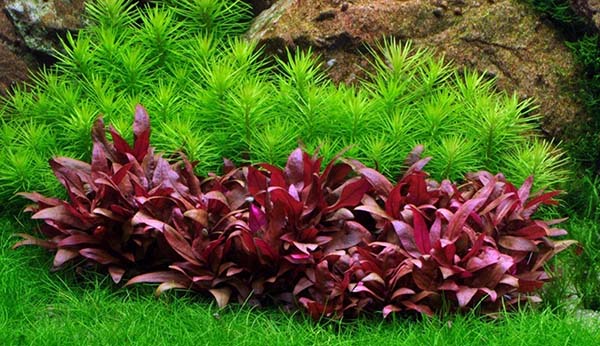
Features of planting, care and cultivation:
- Demanding on heat and does not tolerate frosts, therefore, they are transplanted into containers for the winter.
- You can only water it with warm water.
- In order to achieve maximum decorative effect, the alternanter must be pruned regularly. This process contributes to the bushiness of the plant and the abundant appearance of leaves.
- Propagated by cuttings (in spring).
Amaranth
A large annual herb that can grow up to 2 meters in height. It is widely distributed in warm and temperate climatic zones. It has a powerful straight stem, on which massive elliptical leaves are alternately located. The inflorescences are spike-shaped, inclined, and consist of an abundance of small flowers. Their color depends on the variety of the plant and is green, yellow, red. Amaranth seeds have a high nutritional value, so it is grown not only for decorative, but also for medicinal purposes (for eating).
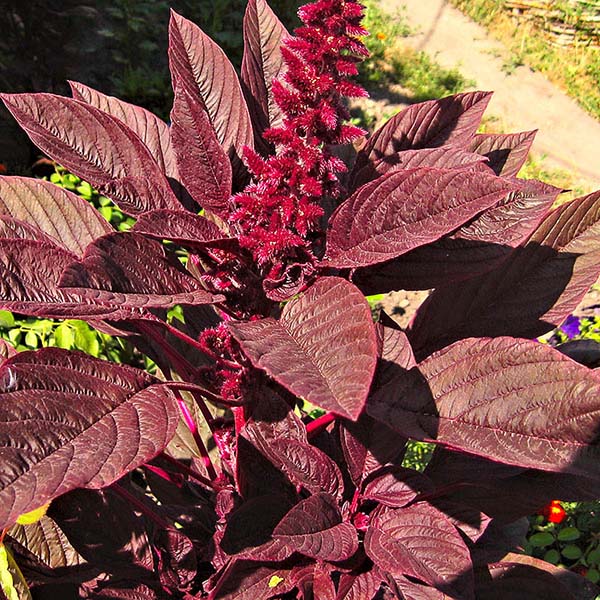
Some varieties of paniculate and tricolor amaranth have red leaves:
- Scarlet;
- Cherry Velvet;
- Illumination;
- Pygmy Torch;
- Sad.
- Red Meath;
Growing features;
- As a rule, the seeds must be sown directly into open ground (it does not tolerate picking well).
By the way! Amaranth requires a lot of nutrients to grow, so its large size may indicate the general fertility of the soil on the site.
Badan
The most beautiful red-leaved varieties of badan:
- Heart-leaved Eroica (Eroica);
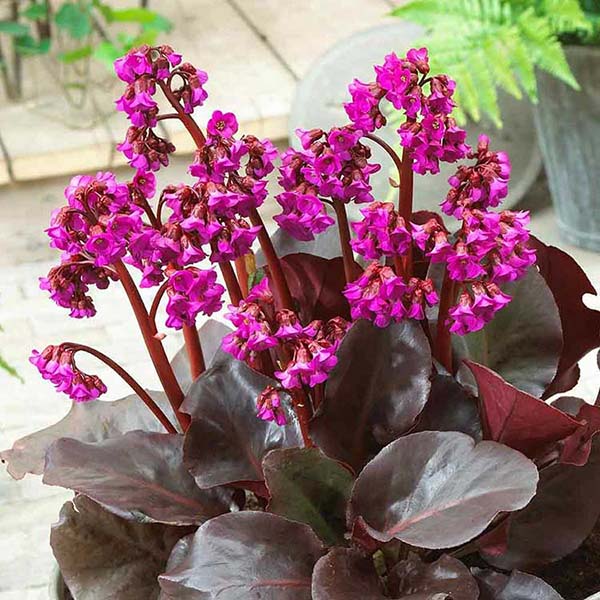
- Hybrid Dragonfly Flirt (Flirt Dragonfly);
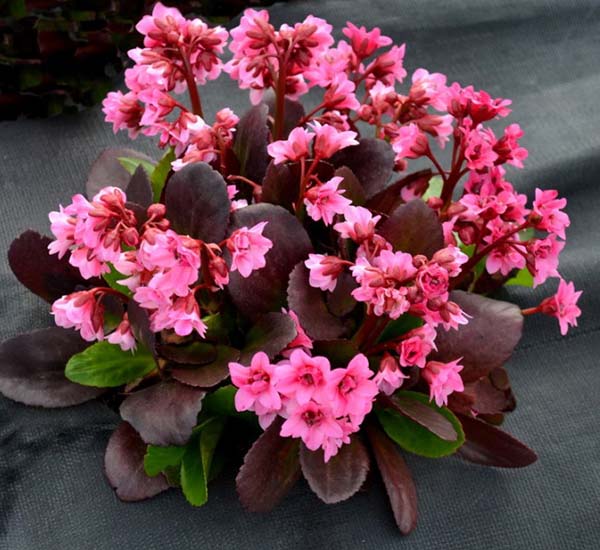
Features of care and cultivation:
- It can be grown both from seeds (but the process is very long), and by dividing rhizomes.
Ever-flowering begonia
A low (one might even say a ground cover) flowering plant, up to 20-30 cm high with juicy leaves and small simple (but beautiful!) Flowers that bloom in early June.
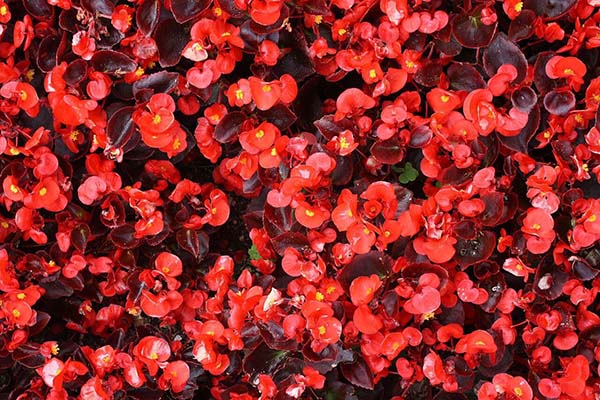
Features of care and cultivation:
- Regular watering, immediately after the topsoil has dried.
- Periodic feeding with special fertilizers for begonias is required.
- They look beautiful in various group plantings (in flower beds, in flower beds and arabesques).
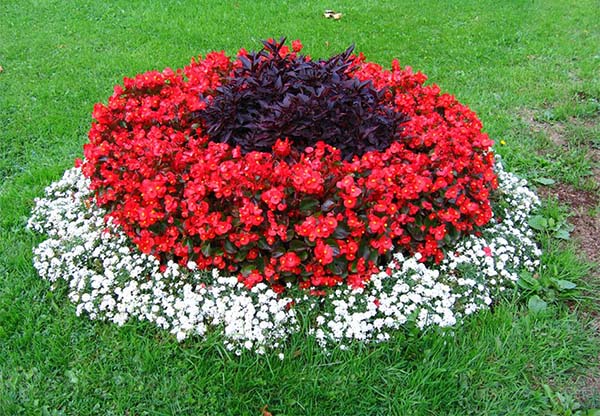
- As a rule, this is still a container culture (especially not in the South).
- It is grown through seedlings, sowing in winter with further picking and planting in open ground no earlier than May-June.
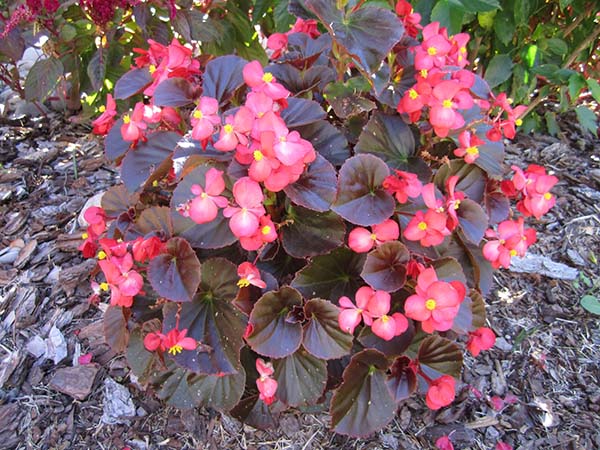
Geichera
Perennial herb. Heuchera leaves are large, can be of various shapes: curly, smooth, corrugated. Their color can be of various shades - purple, red, green.
By the way! The main feature of Heuchera is its leaves, which can change color several times during the season.
Small flower buds, similar to bells, are sometimes also red in color. Blossom in early summer (June-July).
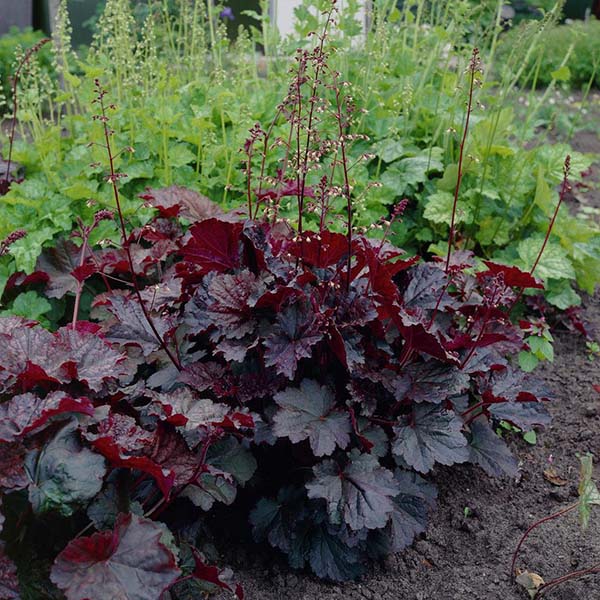
The most decorative are the following types of heuchera:
- Blood red;
- Small-flowered;
- Hybrid.
The most beautiful varieties of red and purple-leaved geyher: Purple Palace, Black Bird, Cherry Cola, Peach Flambe, Amethyst Mist, Midnight Rose.
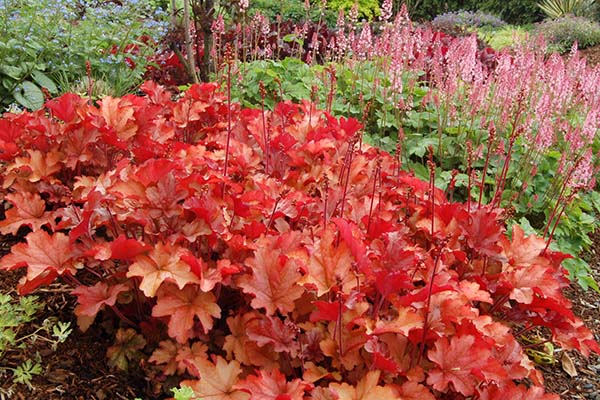
Growing features:
- For normal development, heuchera requires a permeable soil.
- Water the plant in moderation.
- It will be great if you spud the bushes once a year.
- In the fall, pruning is not required, and in the spring, dried foliage will simply need to be removed.
Maple-leaved hibiscus (red-leaved or sour)
It got its name from the shape of the leaves that resemble maple. The leaves are large, predominantly red in color, their diameter can reach 15 cm. Flowers located in the axils of the leaves, usually red or burgundy, up to 11 cm in diameter. The stems are pubescent or completely naked.
The most popular sour hibiscus variety is Mahogany.
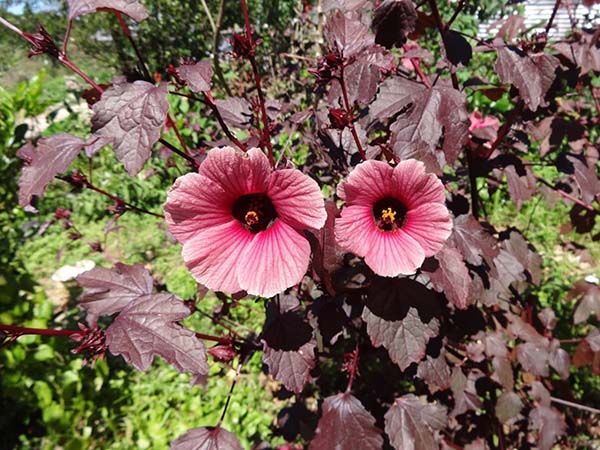
Interesting! Maple-leaved hibiscus will receive a second name - sour due to the sour taste of leaves and stem.
Planting and care features:
- As a rule, the plant is grown in the open field, previously through sowing for seedlings.
- It is worth choosing a well-lit area without drafts.
- Loves moist and well-drained soil.
- In autumn it is well cuttings.
By the way! It is mainly used as a tapeworm.
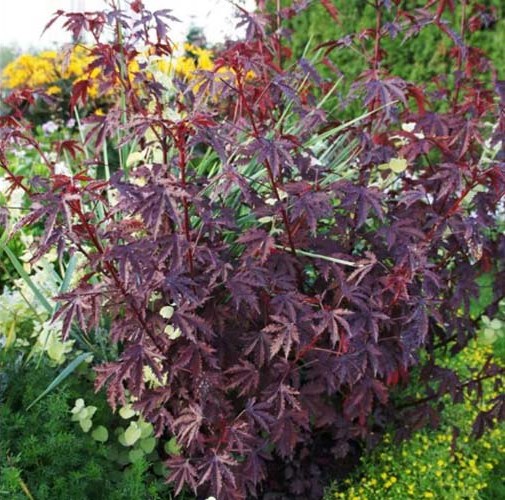
Hypoestes or gepests
Red-leaved varieties of hypoestes (gepestes):
- Splash;
- Carmina;
- Purpuriana.
By the way! It is more often grown as an indoor crop, but you can try and plant it in the garden.
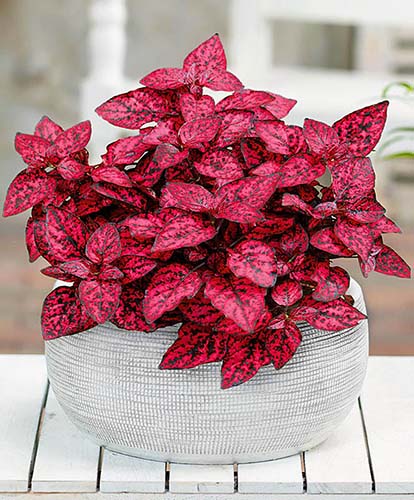
Creeping insect
One of the most popular ground cover plants for a shady garden.
Important! As a rule, the creeping tenacious acquires a purple foliage color closer to autumn.
The most popular red-leaved (more precisely, purple-leaved) varieties:
- Burgundy Glow;
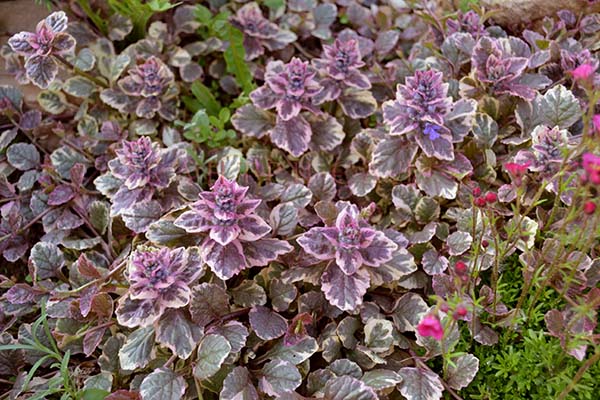
- Catlins Giant (Catlin's Giant);
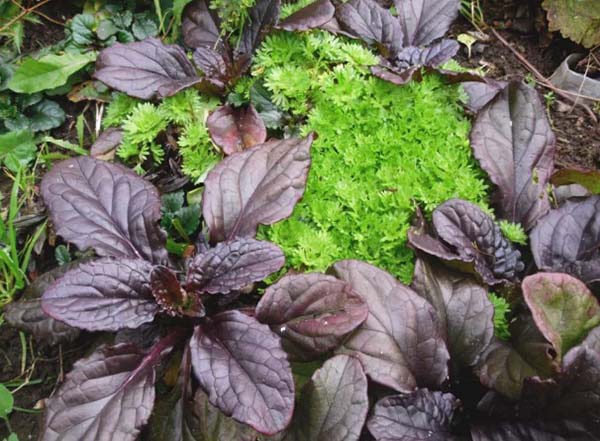
- Multicolor (Multicolor).
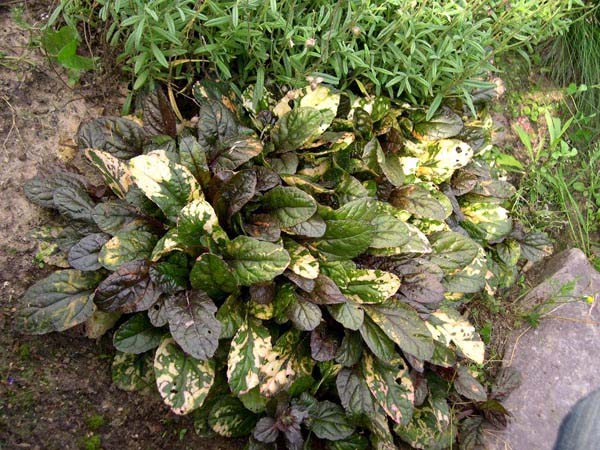
Growing features:
- Loose (moisture-permeable) fertile soil is required.
- Prefers partial shade and even shade.
- Reproduces vegetatively using daughter rosettes.
Morning glorySweet potatovarieties "Blackie"
This is an amazing perennial with very decorative leaves, the roots of which can be eaten and even used for medicinal purposes.
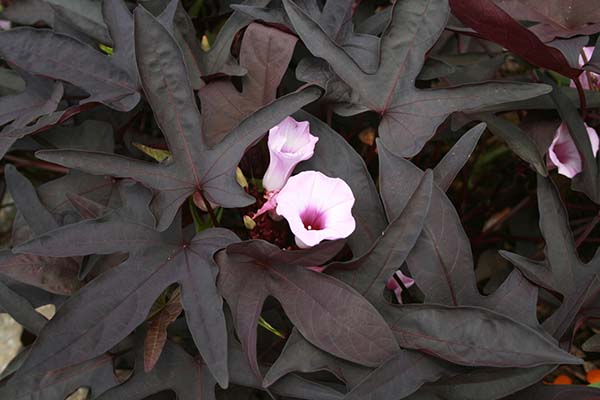
Features of care and cultivation:
- It can grow both on sandy loam and on loamy, but necessarily fertile enough soils.
- It reproduces well by sowing seeds in open ground.
Irezina Herbst
An annual that is prized for its bright burgundy leaves with distinct red veins. The flowers are inconspicuous, small, white or yellowish.
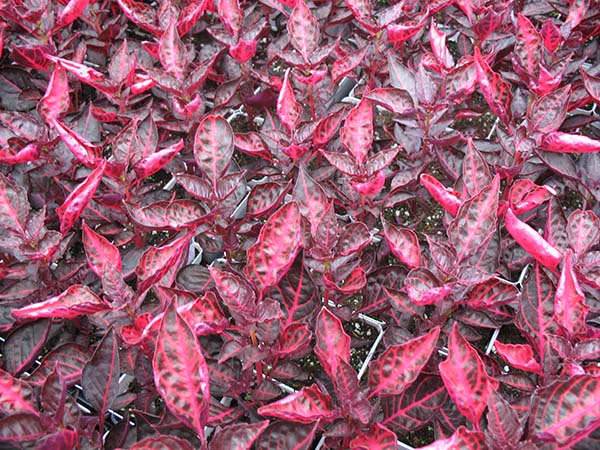
The most popular Herbst irezines are:
- Brilliantissima;
- Wallisii.
Features of care for irezin:
- As a rule, it is grown at home, but can also be planted in the garden (take it home for the winter).
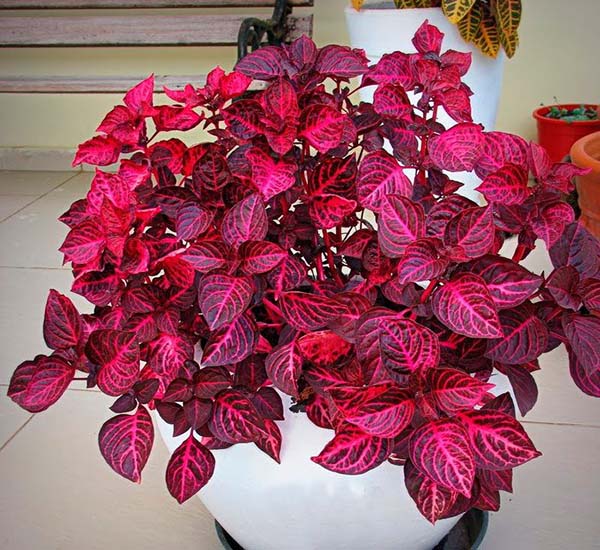
- The temperature should not drop below + 10-15 degrees, otherwise the plant will shed its leaves and get sick.
- It is famous for its fast growth in good lighting conditions. With a lack of light, the leaves lose their color intensity.
- For better bushiness, plants are pinched and pruned.
- Propagated by cuttings (in spring).
Canna garden
Red-leaved (purple) varieties of cannes garden:
- America;
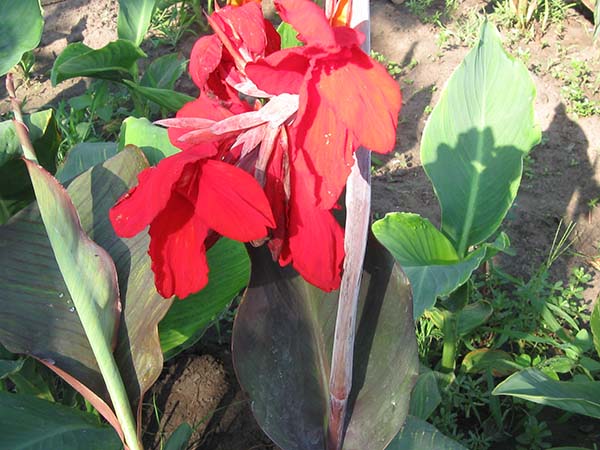
- The president;
- Livadia;
- Flame of Crimea;
- Red Futurity;
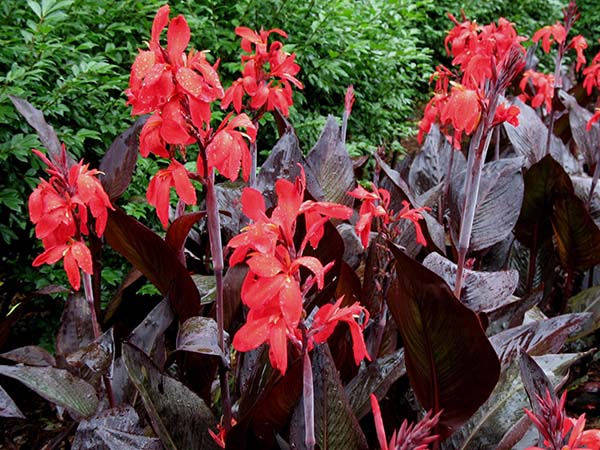
Features of planting and growing:
- Requires regular watering and periodic feeding;
- Digging is necessary for the winter (the plant is thermophilic);
- They reproduce, as a rule, vegetatively - by divisions, but can also be grown from seeds.
Violet oxalis (triangular)
A perennial plant with a dense cap of leaves similar to butterflies. Each leaf is divided into three triangular parts and is purple in color. Flowers are small in size and can be yellow, white or pink.
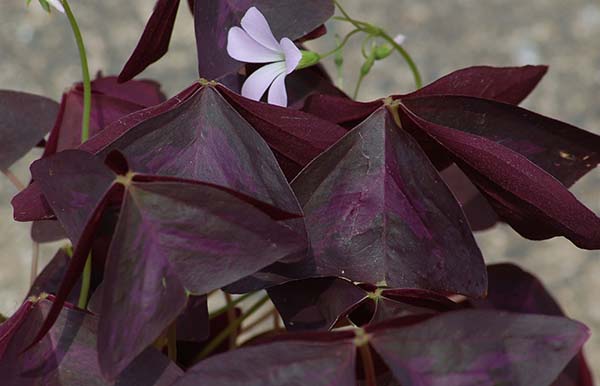
Interesting! A feature of the plant is the ability to close the leaves in unfavorable weather (cloudy) and at night.
Oxalis is unpretentious in care, but the quality of foliage and flowers depends on the following factors:
- The place of growth should be well lit, but the plant should be protected from direct sunlight.
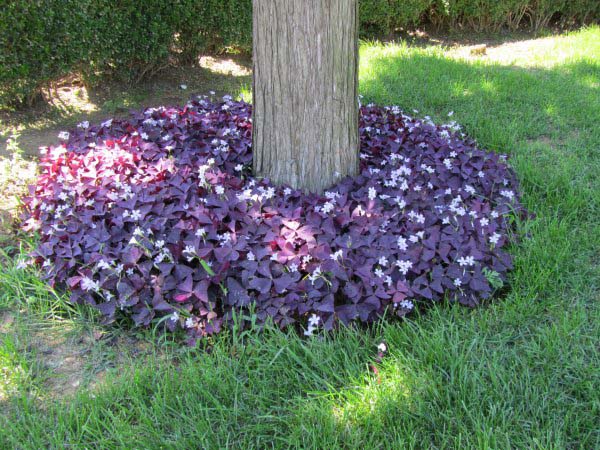
- During the flowering period, the number of waterings should be increased.
- Regular spraying of the leaves has a beneficial effect on the condition of the flower.
- During the rest period, the plant should be removed to a cool place, and stop spraying the foliage.
- Violet oxalis feels great both in indoor and in garden cultivation.
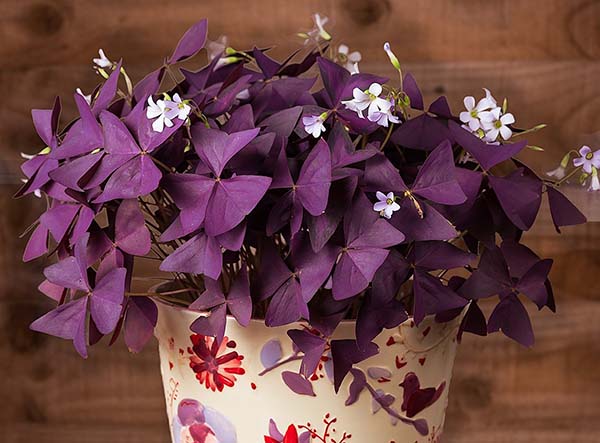
Creeping clover
Truly one of the most unusual ground cover perennials, growing indefinitely (therefore, its growth needs to be controlled).
Red-leaved varieties:
- Purpurascens Quadrifolium;
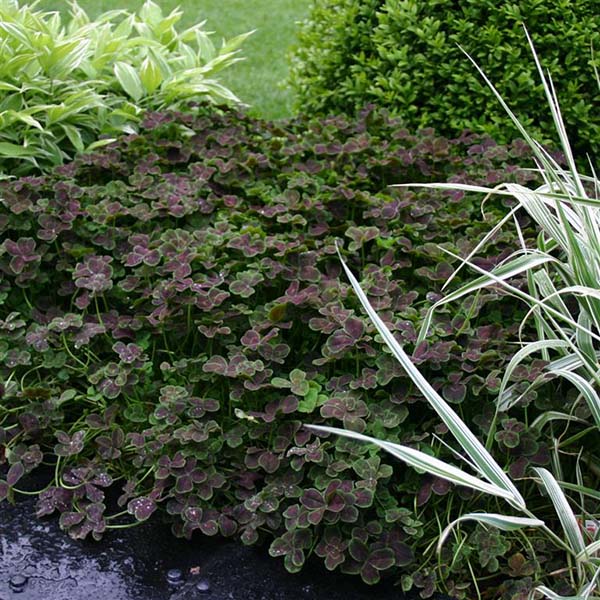
- Purpurascens.
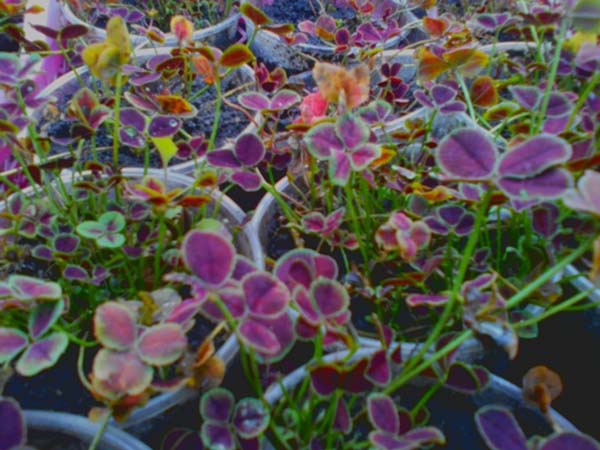
Castor oil plant
Excellent fast-growing ornamental plant for the garden. Looks great in single planting, less often planted in groups. Can be used to decorate a fence or low walls.
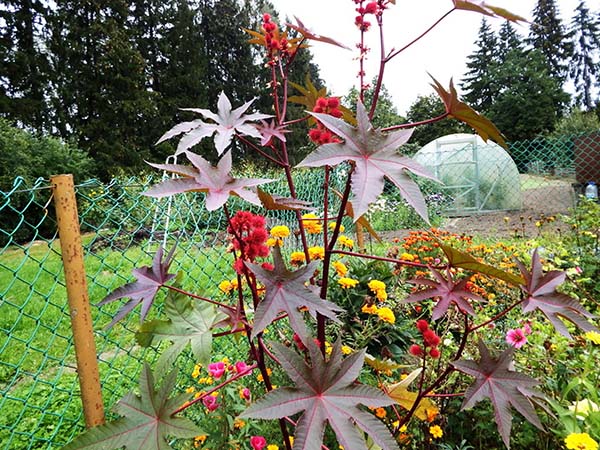
Note! The plant is poisonous, all of its parts contain the protein ricin and the alkaloid ricinin.
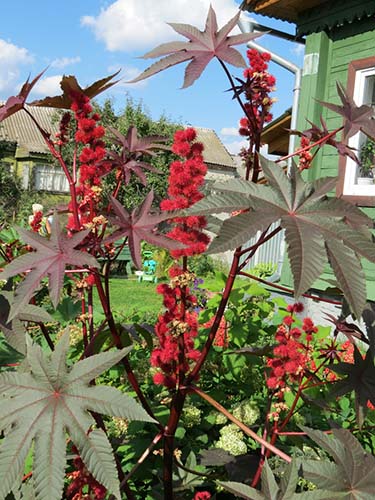
The following types of castor plants have red shades of leaves:
- Bourbon;
- Gibson;
- Impala;
- Zanzibar.
Coleus
A perennial herb with bright, velvety leaves, shaped like nettle leaves. Their color ranges from burgundy to pink. Small flowers fade against the background of elegant leaves, spoil the general appearance of the plant. For this reason, some gardeners cut them.
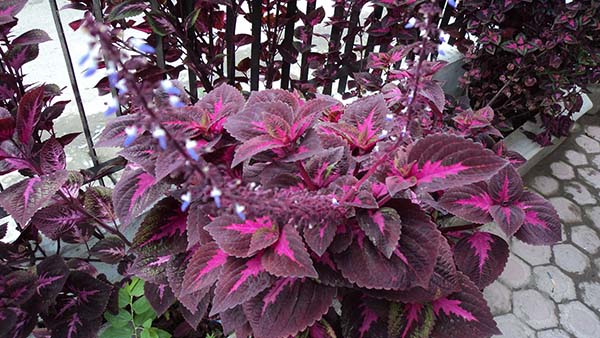
The most popular varieties of Coleus:
- Blume red varieties;
- Velvet Red;
- Crimson Ruffles;
- Black Dragon.
Basic rules for growing:
- Prefers sunny places, regular watering and high humidity.
- Looks beautiful both in a single fit and in a composition.
- You can grow at home and in garden beds (but bring it into the apartment for the winter).
- It propagates well by cuttings (in spring). Can be grown from seeds.
By the way! The root and aerial parts of the plant can be used for medicinal purposes.
Croton (Codium) motley
Croton is a poisonous indoor perennial plant. Stems are strong, straight, they are mainly lanceolate leaves. The leaf has smooth edges, less often - wavy, painted green with stains of various shades (can be yellow, white, red).
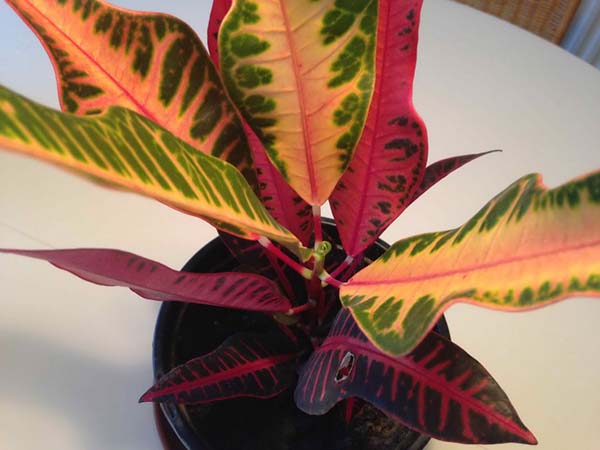
Croton can compete with indoor plants, but requires knowledge in the intricacies of care:
- Prefers bright diffused lighting.
- Afraid of cold, drafts, even in the summer, you should not take croton out into the open air.
- With a lack of moisture, it can shed its leaves, so the plant should be watered and sprayed regularly.
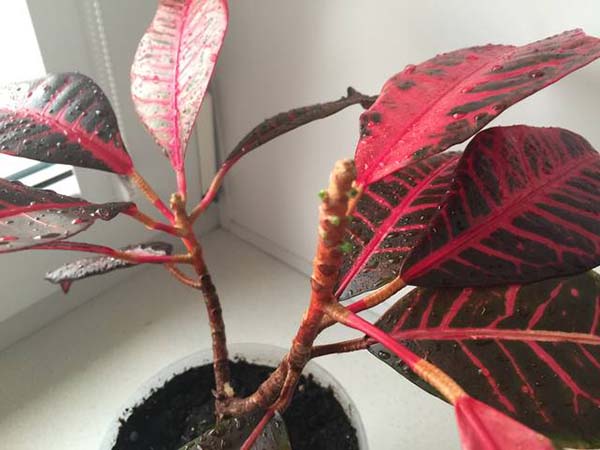
- An annual transplant will help the plant grow.
Toadflax purple varieties "Canon J.Went"
This is a very bright and unusual perennial. It has maroon leaves and peduncles, while the inflorescences themselves are pale pink. Flowering occurs in June-July.
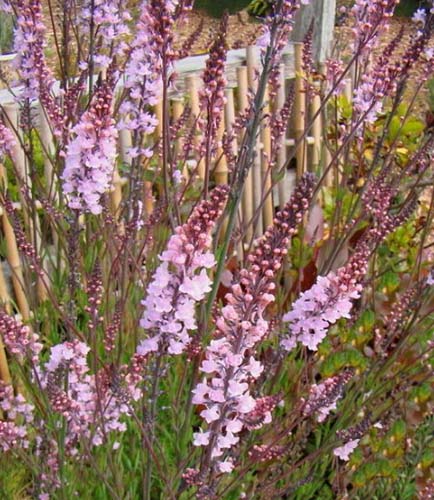
Growing features:
- Prefers drained soil.
- Grows well in the sun.
- Drought-resistant.
- Propagated by seeds, while they must be sown directly into open ground (April-May).
Small-headed Highlander Red Dragon (Red Dragon)
A perennial plant with dark red shoots and heart-shaped leaves that have a metallic sheen. In summer, the leaves are dominated by a green tint, closer to autumn - red. The flowers are small, white, and have almost no decorative properties.
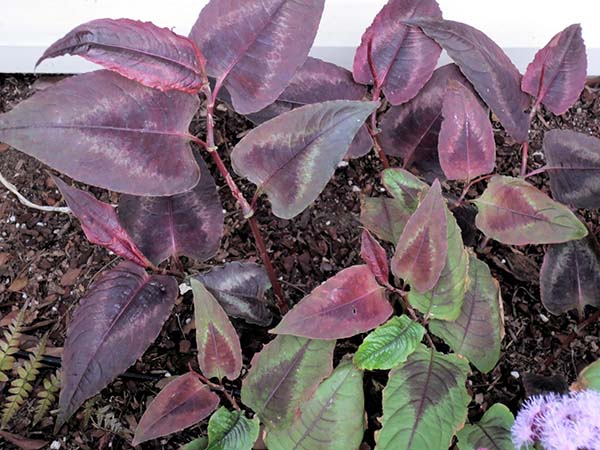
Planting and care features:
- Prefers moderate humidity, tolerates drought well.
- Not picky about soil fertility.
- It is better to cover for the winter.
- Can be used as tapeworm or in compositions.
Rogers feathery
The red leaves have the following varieties of Rogers pinnate:
- Chocolate Wings;
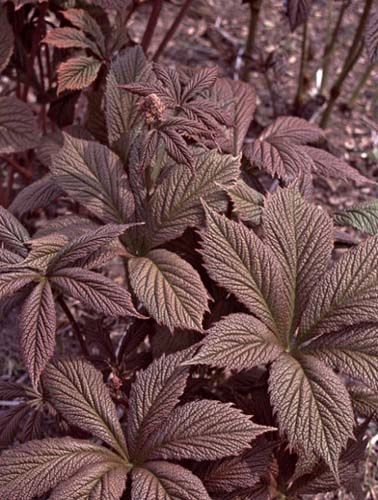
- Superba (Superba).
Features of planting and growing:
- Moist, fertile and loose soil is required.
- Looks beautiful in a single fit (like a tapeworm).
- Propagated by dividing rhizomes.
Important! ABOUT yellow plants (with leaves and / or flowers) read in this article.
Ornamental deciduous red annuals and perennials prove that not only flowers can give a plant beauty. Their leaves of red shades create worthy competition yellow and green fellows. And the simplicity of cultivation, combined with excellent decorativeness, allow them to fully participate in garden compositions.
By the way! If you also know the names and varieties of red-leaved herbaceous plants and flowers, then write them in the comments.


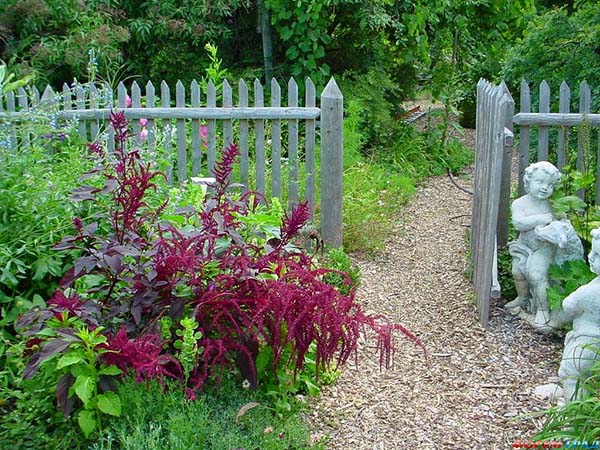
Hello. Everything is great, comprehensive and useful information. But I could not find out about my perennial flower that settled in my dacha 3 years ago. For what, in fact, came.
Good day! Here you cannot do without a photo of your mysterious red perennial ..